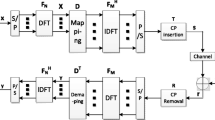Abstract
A novel blind multiple access interference suppression algorithm based on relaxed parallel subgradient projection is proposed for DS/CDMA systems. The qualification “relaxed” is manifest in two aspects: first, the new expression for updating the interference suppression filter coefficients vector relaxes paralleled projection fields and reduces computation complexity. In addition, the relaxation parameter in the updated process is adaptively determined to guarantee the interference suppression filter coefficients vector falling into fields containing the optimal filter coefficients vector after several iterations. Theoretical analysis and simulation results conclude that this algorithm has a fast convergence speed, steady interference suppression performance, low computation and low bit error rate.
Similar content being viewed by others
References
J.A. Apolinario, S. Werner, P.S.R. Diniz, Constrained normalized adaptive filters for CDMA mobile communications, in Proc. EUSIPCO, vol. 4(1) (2000), pp. 1–5
Y. Cai, R.C. Lamare, Low-complexity variable step-size mechanism for code-constrained constant modulus stochastic gradient algorithms applied to CDMA interference suppression. IEEE Trans. Signal Process. 57(1), 313–323 (2009)
R.L.G. Cavalcanta, I. Yamada, Peak-to-average power radio reduction in OFDM systems by the adaptive projected subgradient method, in IEEE Int. Conf. on Acoustics, Speech and Signal Processing, Mar. 31–Apr. 2, 2005, pp. 2270–2275
R.L.G. Cavalcanta, I. Yamada, Multiaccess interference suppression in orthogonal space–time block coded MIMO systems by adaptive projected subgradient method. IEEE Trans. Signal Process. 56(3), 1028–1042 (2008)
P.L. Combettes, Convex set theoretic image recovery by extrapolated iterations of parallel subgradient projections. IEEE Trans. Image Process. 6(4), 493–506 (1997)
Z. Ding, X. Zhang, X. Zhu, A low complexity RLS-PASTd algorithm for blind multiuser detection in dispersive CDMA channels. IEEE Trans. Wirel. Commun. 6(4), 1187–1192 (2007)
M. Honig, M.K. Tsatsanis, Adaptive techniques for multiuser CDMA receivers. IEEE Signal Process. Mag. 17, 49–61 (2000)
M. Honig, U. Madhow, S. Verdu, Blind adaptive multiuser detection. IEEE Trans. Inf. Theory 41(4), 944–960 (1995)
P. Liu, Z. Xu, Blind MMSE-constrained multiuser detection. IEEE Trans. Veh. Technol. 57(1), 608–615 (2008)
S.C. Park, J.F. Doherty, Generalized projection algorithm for blind interference suppression in DS/CDMA communications. IEEE Trans. Circuits Syst. II 44(6), 453–460 (1997)
H.V. Poor, X. Wang, Code-aided interference suppression for DS/CDMA communications—Part II: Parallel blind adaptive implementations. IEEE Trans. Commun. 45(9), 1112–1122 (1997)
J. Qiao, L. Zhao, C. Zou, An acoustic echo cancellation technique based on kurtosis subgradient projection algorithm, in Proc. of the IEEE Int. Conf. on Automation and Logistics, 16–19 Aug. 2007, pp. 474–479
H. Sakai, T. Sakaguchi, Performance analysis of a new adaptive algorithm for blind multiuser detection, in Proc. EUSIPCO, vol. I (2002), pp. 379–382
Q. Wang, J. Qiao, L. Zhao, C. Zou, Acoustic feedback cancellation based on adaptive projection subgradient method in hearing aids, in The 2nd Int. Conf. on Bioinformatics and Biomedical Engineering, 16–18 May 2008, pp. 2008–2011
X. Wang, H.V. Poor, Blind multiuser detection: a subspace approach. IEEE Trans. Inf. Theory 44(2), 677–690 (1998)
I. Yamada, M. Yukawa, An efficient robust stereophonic acoustic echo canceller based on parallel subgradient projection techniques, in The 6th Int. Conf. on Signal Processing, 26–30 Aug. 2002, pp. 293–296
I. Yamada, K. Savakis, K. Yamada, An efficient robust adaptive filtering algorithm based on parallel subgradient projection techniques. IEEE Trans. Signal Process. 50(5), 1091–1101 (2002)
M. Yukawa, R.L.G. Cavalcanta, I. Yamada, Efficient blind MAI suppression in DS/CDMA systems by embedded constraint parallel projection techniques. IEICE Trans. Fundam. E88-A(8), 2062–2071 (2005)
I. Yamada, K. Slavakis, M. Yukawa, Adaptive projected subgradient method and its applications to robust signal processing, in IEEE Int. Symp. on Circuits and Systems, 21–24 May 2006, pp. 1–4
M. Yukawa, K. Slavakis, I. Yamada, Adaptive parallel quadratic-metric projection algorithms. IEEE Trans. Audio Speech Lang. Process. 15(5), 1665–1680 (2007)
Author information
Authors and Affiliations
Corresponding author
Additional information
This Work was supported by the National Natural Science Foundation of China (no. 60872073), and the Natural Science Foundation of Jiangsu Province (no. BK2008291), and the Specialized Research Fund for the Doctoral Program of Higher Education (no. 20050286001) and the Program for New Century Excellent Talents in University (no. NCET-04-0483).
Rights and permissions
About this article
Cite this article
Wei, X., Zhao, L. & Zou, C. Blind Multiple Access Interference Suppression Algorithm Based on Relaxed Subgradient Projection for DS/CDMA Systems. Circuits Syst Signal Process 29, 769–780 (2010). https://doi.org/10.1007/s00034-010-9170-z
Received:
Revised:
Published:
Issue Date:
DOI: https://doi.org/10.1007/s00034-010-9170-z




